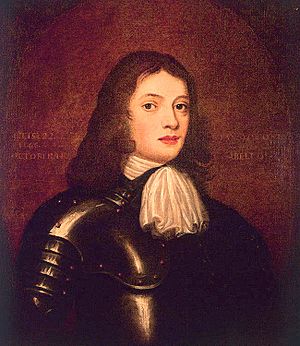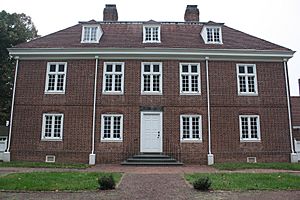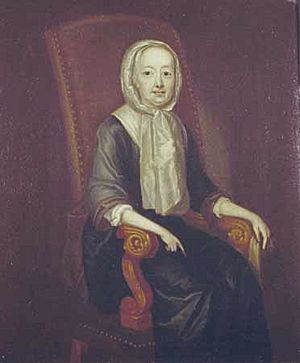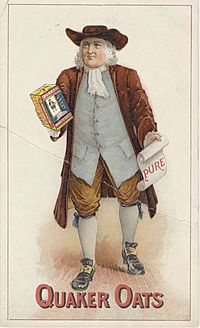William Penn facts for kids
Quick facts for kids
William Penn
|
|
|---|---|
 |
|
| Born | 14 October 1644 |
| Died | 30 July 1718 (aged 73) |
| Alma mater | Chigwell School Christ Church, Oxford |
| Occupation | Nobleman, writer, colonial proprietor of Pennsylvania |
| Spouse(s) | Gulielma Penn Hannah Margaret Callowhill |
| Children | 17, including William Jr., John, Thomas, and Richard |
| Parent(s) | Admiral Sir William Penn Margaret Jasper |
| Signature | |
William Penn (born October 14, 1644 – died July 30, 1718) was an English writer and religious thinker. He belonged to a group called the Religious Society of Friends (also known as Quakers). Penn founded the Province of Pennsylvania, which was an English colony in North America.
He was an early supporter of democracy and religious freedom. He was also known for his good relationships and successful agreements with the Lenape Native Americans.
In 1681, King Charles II gave Penn a large piece of land in North America. This was to pay back debts the king owed to Penn's father, Admiral Sir William Penn. This land became the states of Pennsylvania and Delaware. Penn sailed to America and first arrived in New Castle in 1682. The colonists there promised loyalty to Penn as their new owner. The first Pennsylvania General Assembly (a government meeting) was held.
Afterward, Penn traveled north along the Delaware River and founded Philadelphia. This city was on the west bank of the river. However, the Quaker government Penn set up was not popular with the earlier Dutch and Swedish colonists, or with other English settlers in what is now Delaware. These settlers wanted their own assembly. In 1704, the three southernmost counties of Pennsylvania were allowed to separate. They became the new colony of Lower Delaware. New Castle became its capital.
Penn was one of the first people to suggest that all English colonies in America should unite. The ideas of democracy he put into the Pennsylvania Frame of Government inspired the people who wrote the U.S. Constitution in 1787.
Penn was a very religious man. He wrote many books about his faith. He was put in prison several times in the Tower of London because of his beliefs. His book No Cross, No Crown (1669), written while he was in prison, is still an important Christian book today.
Contents
William Penn: Founder of Pennsylvania
Early Life and Education
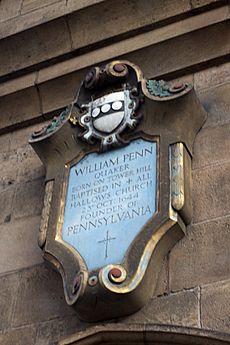
William Penn was born in 1644 in London. His father was Sir William Penn, an English naval officer. His mother was Margaret Jasper, a Dutchwoman. Admiral Penn served in the navy and was given land in Ireland. He also helped bring back King Charles II to the throne and was knighted.
Young Penn grew up during a time of big changes in England. When he was four, King Charles I was beheaded. Penn's father was often away at sea. Penn got smallpox when he was young and lost his hair. His parents moved to an estate in Essex, where Penn grew to love gardening. Their neighbor was the famous writer Samuel Pepys.
Penn went to Chigwell School and later to Christ Church at Oxford. Schools at that time were mostly linked to the Anglican Church. Penn's education focused on old classical writers. His favorite sport was foot racing. The school was very strict. Even though Penn later disagreed with the Anglican Church, he learned many serious behaviors from his Puritan-style education.
When Penn was about fifteen, he met Thomas Loe, a Quaker missionary. Loe spoke about the "Inner Light" (God's presence within each person). Penn felt deeply moved by these ideas.
After his father helped bring back the King, Admiral Penn became a powerful official. In 1660, William Penn went to Oxford. He saw how other students treated Quakers badly. Penn felt sympathy for the Quakers. He became a quiet student, thinking about his own beliefs. He realized he didn't agree with his father's military views or his mother's social interests.
Penn considered a career in medicine at Oxford. He liked new ideas in science and politics. He joined discussions with a theologian named John Owen. Penn learned how to form ideas, debate them, and test them in the real world. When Owen was punished, Penn stood by him and was fined by the university. His father pulled him out of Oxford.
At 18, Penn was sent to Paris to improve his manners. He found French manners polite but didn't like the show of wealth. He studied with a French Protestant theologian, Moise Amyraut. Amyraut taught a tolerant view of religion, which Penn liked. Penn felt free to find his own religious path.
After two years, Penn returned to England. He looked sophisticated. His father hoped he would become a successful aristocrat. Penn started law school, but soon joined his father at sea during a war with the Dutch. He acted as a messenger between his father and the King. When the plague hit London in 1665, Penn saw much suffering. He felt that the world's religions were not truly religious. He also saw Quakers being arrested for helping others during the plague.
In 1666, Penn went to Ireland to manage his family's lands. He became a soldier and helped stop a local rebellion. He even had his portrait painted in armor. He thought about a military career, but his father advised him to be sensible. The Great Fire of 1666 happened while he was away, but his family was safe. King Charles made laws stricter against all religions except the Anglican Church. Quakers were especially targeted.
Becoming a Quaker
Despite the dangers, Penn started going to Quaker meetings in Ireland. Meeting Thomas Loe again made Penn even more interested in Quakerism. Soon, Penn was arrested for attending a Quaker meeting. Instead of denying he was a Quaker, he publicly declared himself one at age 22. He argued that Quakers should not be punished because they had no political goals. He was released because of his family's status.
His father was very upset by Penn's choice. He had hoped Penn would have a great career at court. The Admiral tried to change his son's mind, but Penn was determined. His father feared for his son's safety and his own position. In the end, his father told him to leave the house and cut off his inheritance.
Penn then lived with Quaker families. Quakers in the 1600s were very strict Christians. They believed all people were equal under God. This meant they refused to bow or take off their hats to important people, which was seen as disrespectful to the King. They also refused to swear oaths of loyalty. Quakers were treated as heretics and often persecuted. Their worship was usually silent, with no special rituals or paid clergy. Penn found these beliefs matched his own conscience.
Penn became a close friend of George Fox, who founded the Quakers in the 1650s. Many new religious groups appeared during this time. After Oliver Cromwell died, the King returned and persecuted all religions except Anglicanism. Fox risked his life traveling and teaching. He believed that God did not live in buildings made by humans. By giving power to individuals rather than the church, Fox helped spread the idea of individual rights, which is important for modern democracies. Penn traveled with Fox and wrote about Quakerism. He became an important writer and defender of Quaker beliefs.
Persecution and Imprisonment
Penn wrote many pamphlets. His first, Truth Exalted (1668), criticized all religious groups except Quakers. He was put in the Tower of London in 1668 for writing another pamphlet, The Sandy Foundation Shaken. He was accused of denying the Trinity, which he said was a misunderstanding. He was held alone in a cold cell and threatened with a life sentence.
Given writing materials, Penn wrote another book, No Cross, No Crown. In it, he encouraged believers to follow early Christian ways. He was released after eight months.
Penn continued to fight against unfair laws. The Crown kept taking Quaker property and jailed thousands of Quakers. Penn was expelled from Oxford and arrested many times. One famous event was his trial in 1670 with William Mead. Penn was accused of preaching in the street, which he did to challenge a law that limited religious gatherings.
The judge, Sir John Howel, refused to let Penn see the charges against him. He also told the jury to decide without hearing Penn's defense. Despite pressure from the judge, the jury found Penn "not guilty." The judge was angry and sent Penn and the jury to jail. The jury members fought their case from prison. This case, known as Bushel's Case, helped establish the right for English juries to be free from judges' control. It was a victory for individual rights.
Penn's father was dying. He paid Penn's fine to release him from prison. His father told him, "Let nothing in this world tempt you to wrong your conscience." The Admiral also asked the Duke of York, the future king, to protect Penn. The Duke and King promised to protect Penn.
Penn inherited a large fortune. He was jailed again for six months for continuing his activism. In April 1672, he married Gulielma Springett. Penn continued to write about religious tolerance. He also did missionary work in Holland and Germany.
Founding Pennsylvania
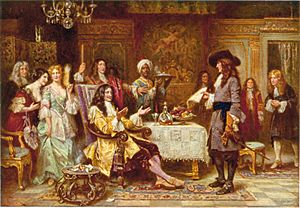
Penn saw that conditions for Quakers were getting worse in England. He suggested that English Quakers should move to North America. Some Quakers had already moved there, but Puritans in New England were also hostile to them. In 1677, Penn and other Quakers bought the colony of West Jersey (part of present-day New Jersey). Many Quaker settlers arrived and founded towns like Burlington.
Penn then asked the King to expand the Quaker region. To his surprise, the King gave Penn a huge charter, making him the largest private landowner in the world. Penn became the owner of a vast area west of New Jersey and north of Maryland. He had ruling power over this land, except for declaring war. The land was called "Pennsylvania" by King Charles II, in honor of Penn's father. The King signed the charter on March 4, 1681.
Penn traveled to America and bought the first piece of land from the Lenape Native Americans. He wrote a charter of liberties for the new settlement. This charter created a political utopia (an ideal society). It guaranteed fair trials by jury, freedom of religion, freedom from unfair imprisonment, and free elections.
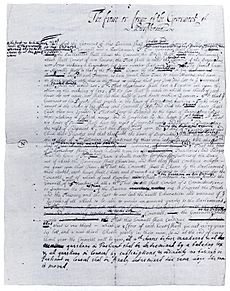
Penn wanted Pennsylvania to be a profitable place, but he also promised not to take advantage of Native Americans or immigrants. He sold land to the Lenape but allowed them to continue hunting and fishing on it. To attract settlers, he wrote a detailed prospectus (a kind of advertisement). It promised religious freedom and financial benefits. He sold land to over 250 settlers, mostly wealthy London Quakers. He also attracted other groups who were persecuted, like Huguenots, Mennonites, Amish, Catholics, Lutherans, and Jews from many European countries.
Penn worked to create a legal system for an ethical society. He wanted power to come from the people, like in a Quaker meeting. Penn also limited his own power as the ruler. The new government would have two parts, protect private property, allow free business, and tax fairly. It would only have the death penalty for two crimes (treason and murder), unlike the two hundred crimes in English law. All cases would have a jury. Prisons would try to improve people through "workshops." Laws against swearing, lying, and "idle amusements" like plays or gambling were also included.
These ideas were very different from the laws of European kings. Penn worked on his "Framework of Government" with help from Thomas Rudyard, a Quaker lawyer. He used ideas from John Locke but added his own revolutionary idea: using amendments. This meant the written rules could change over time. Penn hoped this would allow for new ideas and peaceful changes without violence. The King could still overrule any law, but Penn's careful leadership avoided problems while he was in Pennsylvania.
Under Penn's guidance, the city of Philadelphia was planned. It had a grid-like street layout, making it easy to navigate, unlike London. Streets were named with numbers and tree names.
Later Years and Legacy

In 1684, Penn returned to England to see his family and settle a land dispute with Lord Baltimore. Penn had not clearly marked the southern border of his land. This led to an 80-year legal battle between the two families.
Political conditions in England were difficult. Penn found prisons full of Quakers. In 1685, King Charles died, and James II became king. King James, a Catholic, was stubborn. Penn supported James's Declaration of Indulgence, which allowed religious tolerance for Quakers.
Penn also faced financial problems. His business manager, Philip Ford, cheated him out of a lot of money. Ford claimed ownership of Pennsylvania and demanded rent from Penn.

After dealing with some financial issues, Penn returned to Pennsylvania in December 1699 with his wife Hannah, daughter Letitia, and secretary James Logan.
Penn received a warm welcome. Pennsylvania had grown quickly, with nearly 18,100 people. Philadelphia had over 3,000 residents. His tree plantings had created green spaces. Shops were full of goods, showing America was a good market for English products. Religious diversity was working well. Penn insisted that Quaker schools be open to everyone, which led to an educated workforce. Philadelphia became a leader in science and medicine. Quakers were advanced in treating mental illness, focusing on care rather than punishment.
Penn and his family lived comfortably at Pennsbury Manor and also had a home in Philadelphia. His only American child, John, was born there. Penn spent time with his family and managed state affairs. His wife, however, preferred the simpler life in England. When new threats to his charter appeared, Penn decided to return to England with his family in 1701.
Back in England, Penn faced more financial and family problems. His eldest son, William, Jr., was living carelessly and getting into debt. Penn had hoped his son would take over in America. His own finances were a mess. He had invested a lot in America but received little back.
Philip Ford's widow, Bridget, threatened to sell Pennsylvania, claiming ownership. Penn tried to sell Pennsylvania to the Crown, but he insisted on keeping the civil liberties he had established. Mrs. Ford took her case to court. Penn, at age 62, was put in debtors' prison. However, he was soon released, and Bridget Ford's claim was denied. Quakers helped pay Ford for back rents.
In 1712, Penn suffered a stroke. A second stroke left him unable to speak or care for himself. He slowly lost his memory.
William Penn died without money in 1718, at his home in Ruscombe, England. He is buried next to his first wife at the Jordans Quaker meeting house. His wife, Hannah, became the owner of Pennsylvania until she died in 1726.
Penn's Family
William Penn first married Gulielma Maria Posthuma Springett (1644–1694). They had eight children, but many died young. Their children included:
- Springett (1675–1696)
- Letitia (1678–1746)
- William, Jr. (1681–1720)
Two years after Gulielma's death, he married Hannah Margaret Callowhill (1671–1726) in 1696. William Penn was 52 and Hannah was 25. They had nine children:
- John Penn (1700–1746), who never married.
- Thomas Penn (1702–1775)
- Margaret Penn (1704–1751)
- Richard Penn Sr. (1706–1771)
- Dennis Penn (1707–1723)
Penn's Impact and Legacy
After Penn's death, Pennsylvania slowly changed from a religious colony to a more business-focused state. However, many of Penn's legal and political ideas remained. The Quaker school in Philadelphia, which Penn supported, was renamed the William Penn Charter School. It is now the oldest Quaker school in the world.
Voltaire praised Pennsylvania as the only government that listened to its people and respected minority rights. Penn's "Frame of Government" and other ideas were studied by Benjamin Franklin and Thomas Paine, who was a Quaker. One of Penn's important legacies was not forcing a Quaker majority on Pennsylvania. This allowed the state to become a successful "melting pot" of different people.
Thomas Jefferson and the Founding Fathers of the United States used Penn's idea of an amendable constitution. They also adopted his vision that "all Persons are equal under God." Besides his political and religious writings, Penn wrote almost 1,000 wise sayings about human nature and morality.
Penn's family owned Pennsylvania until the American Revolution. However, his sons, Thomas Penn and John, left the Quaker faith. They tried to limit religious freedom, especially for Catholics and later for Quakers. Thomas reduced the power of the elected assembly. He was against Benjamin Franklin's push for more democracy. Through the unfair Walking Purchase of 1737, the Penn family cheated the Lenape out of their lands.
As a pacifist Quaker, Penn thought deeply about war and peace. He suggested a plan for a United States of Europe. This would involve a European Assembly where leaders could discuss and solve problems peacefully. He is seen as the first person to suggest a European Parliament and what later became the modern European Union.
Honors and Recognition
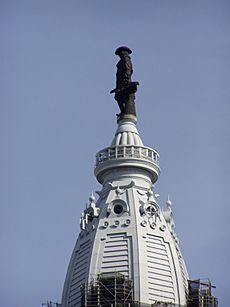
On November 28, 1984, Ronald Reagan, the U.S. President, declared William Penn and his second wife, Hannah Callowhill Penn, to be Honorary Citizens of the United States.
A bronze statue of William Penn stands on top of Philadelphia's City Hall. When it was put there in 1894, it was the highest point in the city. For almost 100 years, people in Philadelphia agreed not to build taller than "the brim of Billy Penn's hat." This changed in 1987 when One Liberty Place was built taller. This led to a "curse" for Philadelphia sports teams. The curse supposedly ended in 2008 when a small statue of William Penn was placed on top of the Comcast Center. That year, the Philadelphia Phillies won the 2008 World Series.
Another statue of Penn is at Penn Treaty Park. This is where Penn made his famous treaty with the Lenape. This event is shown in the painting Penn's Treaty with the Indians.
The Quaker Oats cereal brand uses a "Quaker man" logo. After 1909, this logo was sometimes identified as William Penn. However, the company now says their logo is not a picture of William Penn.
Bil Keane created a comic called Silly Philly for the Philadelphia Bulletin. It featured a young version of Penn and ran from 1947 to 1961.
William Penn was played by Clifford Evans in the 1941 film Penn of Pennsylvania.
The William Penn High School for Girls was added to the National Register of Historic Places in 1986.
The William Penn House, a Quaker hostel in Washington, D.C., was named after him in 1966. Chigwell School, where Penn studied, has named one of its houses after him. A pub in Rickmansworth, England, where Penn lived, is called "The Pennsylvanian."
The Friends' School, Hobart in Australia has named one of its classes after him. William Penn University in Iowa, founded by Quakers, is named in his honor. Penn Mutual, an insurance company, also carries his name.
Several streets are named after William Penn, including Penn Avenue in Pittsburgh and Scranton, and Penn Street in Bristol.
See also
 In Spanish: William Penn para niños
In Spanish: William Penn para niños
- Penn–Calvert boundary dispute
- Nicholas More



